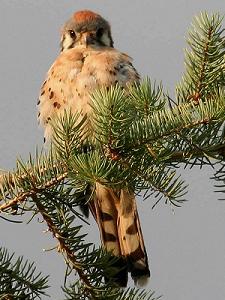American Kestrel 
Identification and Pictures
(Falco sparverius)
American kestrels, also called Sparrow hawks are very
colorful small falcons about 9 to 12 inches, with long, narrow, pointed wings. They have short necks, and the head is crowned
blue-gray with some orange. They have a Short, dark, hooked beak,
and there are two dark mustache marks on the face. The
large talon-tipped feet are ideal for hunting. They have rufous brown tail with a dark tip, and a rufous brown back.
The tail is white underneath with a few black bars.
Their under parts are pale buff to orange, with black spots.
The males have blue-gray wings with black spots. Both
sexes have a white face with two black vertical bars. Females are
slightly larger than males. The back of the female's wings and tail are rusty brown with fine dark
bars. Young birds have a lot of barring on their back, and
a buffy chest with streaking.
Photos by Keith
Lee. The camera I use is the Canon
EOS 40D. Visit All-birds store

They like to sit on tree tops, fence post, or
wires in an erect position. They may be seen hovering in one spot, with
rapid beating wings, like a kingfisher.
Kestrel sound
Sound is sharp metallic notes like
klee-klee-klee. This is given during courtship, and when alarmed.
Both sexes also make whining calls during mate feeding.
Preferred Habitat
Kestrels are the most common falcon in North America.
They can be found across Canada in the summer, and are year
round residents across the U.S. The northern birds are migratory.
They like the edges of wooded
areas, farmland and residential areas. They need to have
open ground for hunting.
Breeding and Nesting
After the male establishes a territory a
female will start doing activities such as hunting with him. The pair will usually
bond for life. Kestrels breed in the spring from April to early June
in open habitats such as
grasslands, meadows, deserts, and agricultural fields.
They nest in cavities in trees, cliffs, or in a nestbox.
Falcons do not build nests and will use cavities excavated by flickers, and other large woodpeckers.
They do not add nesting materials to the cavity. Since they need a large hole, and they can't make their own, nesting sites are always in
short supply. On rare occasions they have been known to nest in an old bird
nest such as a Magpie nest. Like many birds the male brings the female morsels of food during courtship.
After they have chosen a nesting site he will continue to bring her food while she lays
4 to 5 whitish eggs with brown dots on them. The female
does most of the incubation for around 30 days. After about 11 weeks the young will take short flights from the nest waiting in trees for the parents to feed them.
Food
Kestrels eat insects, small birds, and small animals like mice.
They are able to catch small birds and for this reason was once call a Sparrow Hawk.
Kestrels may nest in boxes placed on your
property.
Here is a nestbox design with
dimensions.
To learn about other favorite
birds click here.
|
